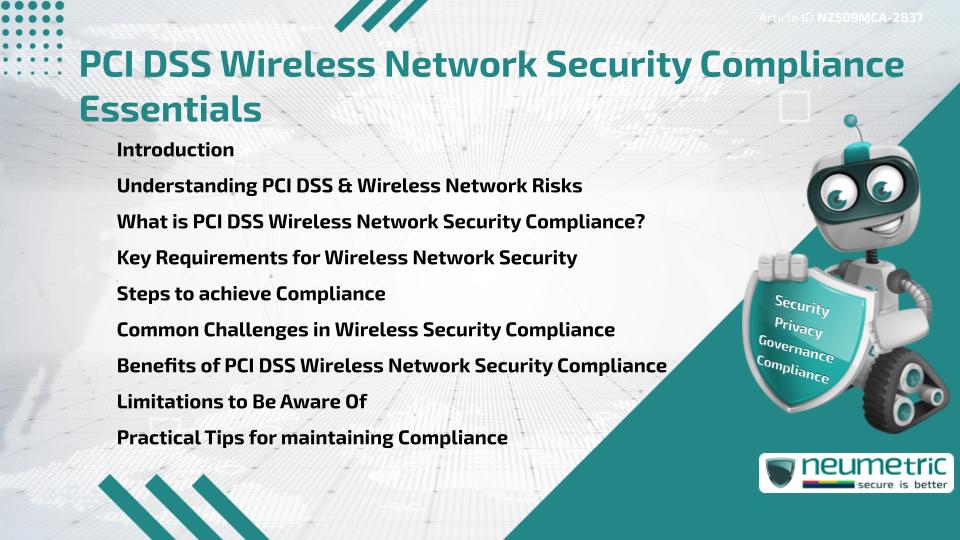Table of Contents
ToggleIntroduction
The PCI DSS wireless network security compliance Framework ensures Organisations protect Cardholder Data transmitted over wireless technologies. Wireless networks are often the weakest link in security, making them attractive to attackers. Compliance with PCI DSS provides controls to secure these networks, reduce Risks of data theft & maintain Customer Trust. Understanding requirements, challenges & benefits is crucial for businesses handling payment data.
Understanding PCI DSS & Wireless Network Risks
The Payment Card Industry Data Security Standard [PCI DSS] is a set of requirements designed to protect Cardholder Data. Wireless networks introduce Risks such as unauthorized access, rogue access points & weak encryption. Attackers can exploit these Vulnerabilities to capture sensitive payment information.
PCI DSS Compliance emphasizes strong Security Controls to reduce these Risks. By securing wireless environments, businesses can align with Industry Standards & avoid Financial penalties. For background on PCI DSS, visit the PCI Security Standards Council.
What is PCI DSS Wireless Network Security Compliance?
The PCI DSS wireless network security compliance process ensures that Organisations follow PCI DSS requirements specifically for wireless environments. This includes detecting unauthorized devices, applying strong encryption & monitoring wireless traffic for suspicious activity.
The goal is to prevent unauthorized access & secure Sensitive Data in transit. This process applies to all Organisations that transmit, process or store Cardholder Data over wireless networks. A broader explanation of compliance is available at SANS Institute resources.
Key Requirements for Wireless Network Security
To meet PCI DSS wireless network security compliance, Organisations must follow these requirements:
- Identify & monitor all wireless access points
- Use strong encryption protocols such as WPA2 or WPA3
- Change default settings & passwords on wireless devices
- Segment wireless networks from Cardholder Data environments
- Regularly test for rogue access points
- Log & monitor all wireless activity
Details on these requirements can be found in PCI DSS guidance on wireless.
Steps to achieve Compliance
Achieving PCI DSS wireless network security compliance involves:
- Risk Assessment – Identify where wireless networks interact with Cardholder Data.
- Secure configuration – Apply strong encryption, disable weak protocols & change defaults.
- Network monitoring – Continuously monitor for rogue devices & suspicious behavior.
- Testing & audits – Regularly conduct penetration tests & Vulnerability scans.
- Employee Training – Educate staff on secure wireless usage practices.
Further details on compliance steps are explained at IT Governance PCI resources.
Common Challenges in Wireless Security Compliance
Organisations may face obstacles when implementing PCI DSS wireless network security compliance:
- Difficulty detecting unauthorized access points
- Legacy devices that do not support strong encryption
- Limited resources for monitoring & testing
- Employee misuse of unsecured wireless networks
These challenges can be addressed with automated Monitoring Tools, regular training & investment in updated hardware.
Benefits of PCI DSS Wireless Network Security Compliance
Compliance with PCI DSS wireless network security Standards provides several benefits:
- Protects sensitive Cardholder Data
- Reduces Risk of breaches & Financial penalties
- Increases Customer Trust & brand reputation
- Supports legal & contractual obligations
- Encourages stronger overall Cybersecurity practices
Limitations to Be Aware Of
While PCI DSS wireless network security compliance improves security, it is not foolproof. Compliance ensures controls are in place but cannot eliminate all Risks. Emerging Threats, Employee negligence or misconfigurations may still create Vulnerabilities. Organisations must combine compliance with proactive Risk Management.
Practical Tips for maintaining Compliance
To maintain PCI DSS wireless network security compliance:
- Regularly update wireless device firmware
- Conduct frequent wireless scans for rogue access points
- Use network segmentation for Sensitive Data
- Review & update wireless Security Policies annually
- Train Employees on safe wireless practices
Takeaways
- PCI DSS protects wireless environments carrying Cardholder Data
- Compliance requires encryption, monitoring & segmentation
- Key benefits include Risk reduction & Customer Trust
- Limitations exist, requiring ongoing vigilance & updates
FAQ
What is PCI DSS wireless network security compliance?
It is the process of applying PCI DSS requirements to secure wireless networks handling Cardholder Data.
Why is wireless network security important for PCI DSS?
Wireless networks are vulnerable to attacks, making strong controls necessary to protect payment information.
Which encryption protocols are required for PCI DSS wireless network security compliance?
PCI DSS requires strong encryption such as WPA2 or WPA3.
How often should Organisations test for rogue access points?
Testing should be performed regularly, at least quarterly or more frequently depending on Risk levels.
Does PCI DSS wireless network security compliance apply to all businesses?
Yes, it applies to any business transmitting, processing or storing Cardholder Data over wireless networks.
What are the penalties for non-compliance?
Penalties can include fines, increased transaction fees or loss of the ability to process payment cards.
Can Small Businesses achieve PCI DSS wireless network security compliance?
Yes, with proper planning, secure configurations & training, Small Businesses can comply effectively.
Need help for Security, Privacy, Governance & VAPT?
Neumetric provides organisations the necessary help to achieve their Cybersecurity, Compliance, Governance, Privacy, Certifications & Pentesting needs.
Organisations & Businesses, specifically those which provide SaaS & AI Solutions in the Fintech, BFSI & other regulated sectors, usually need a Cybersecurity Partner for meeting & maintaining the ongoing Security & Privacy needs & requirements of their Enterprise Clients & Privacy conscious Customers.
SOC 2, ISO 27001, ISO 42001, NIST, HIPAA, HECVAT, EU GDPR are some of the Frameworks that are served by Fusion – a SaaS, multimodular, multitenant, centralised, automated, Cybersecurity & Compliance Management system.
Neumetric also provides Expert Services for technical security which covers VAPT for Web Applications, APIs, iOS & Android Mobile Apps, Security Testing for AWS & other Cloud Environments & Cloud Infrastructure & other similar scopes.
Reach out to us by Email or filling out the Contact Form…





